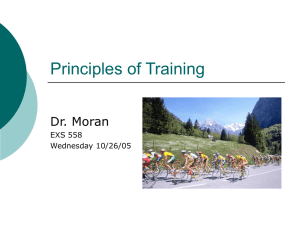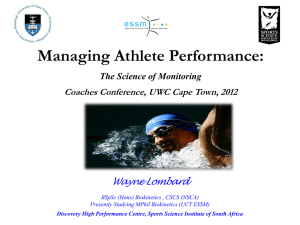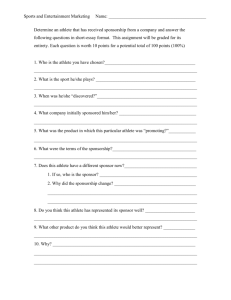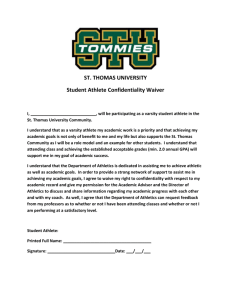principles of training training theory
advertisement
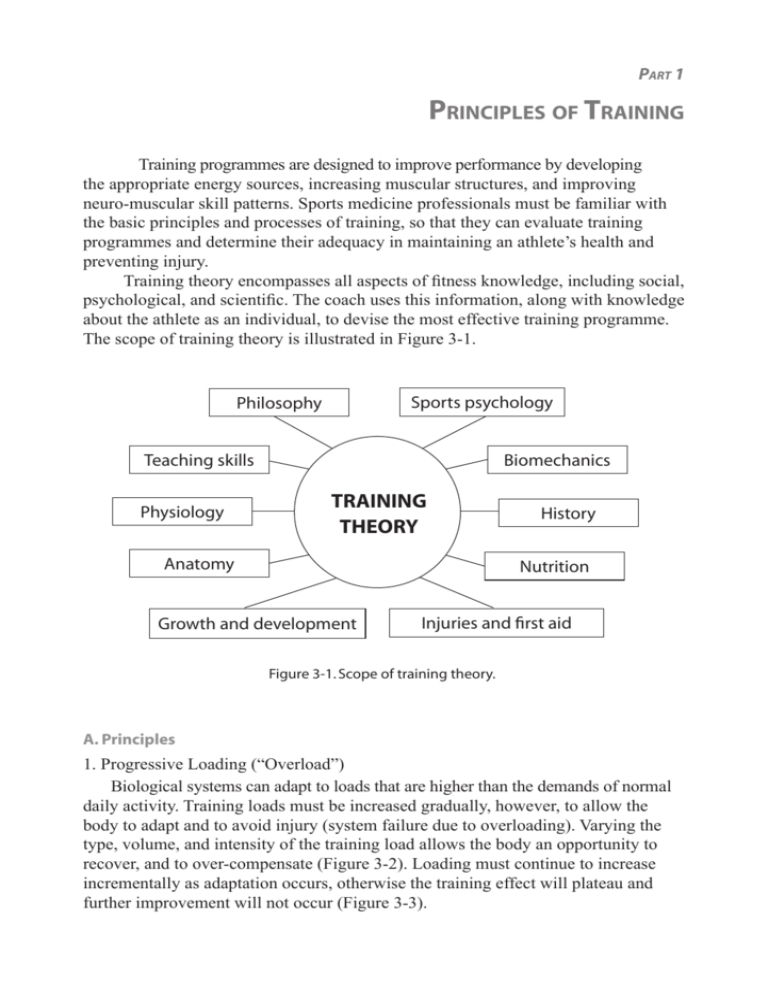
PART 1 PRINCIPLES OF TRAINING Training programmes are designed to improve performance by developing the appropriate energy sources, increasing muscular structures, and improving neuro-muscular skill patterns. Sports medicine professionals must be familiar with the basic principles and processes of training, so that they can evaluate training programmes and determine their adequacy in maintaining an athlete’s health and preventing injury. Training theory encompasses all aspects of fitness knowledge, including social, psychological, and scientific. The coach uses this information, along with knowledge about the athlete as an individual, to devise the most effective training programme. The scope of training theory is illustrated in Figure 3-1. Sports psychology Philosophy Teaching skills Physiology Biomechanics TRAINING THEORY Anatomy History Nutrition Growth and development Injuries and first aid Figure 3-1. Scope of training theory. A. Principles 1. Progressive Loading (“Overload”) Biological systems can adapt to loads that are higher than the demands of normal daily activity. Training loads must be increased gradually, however, to allow the body to adapt and to avoid injury (system failure due to overloading). Varying the type, volume, and intensity of the training load allows the body an opportunity to recover, and to over-compensate (Figure 3-2). Loading must continue to increase incrementally as adaptation occurs, otherwise the training effect will plateau and further improvement will not occur (Figure 3-3). CHAPTER 3, TRAINING Stimulus Overcompensation Fitness Fatigue Compensation Figure 3-2. The law of overload. i i i i i i Fitness Figure 3-3. Principle of progressive overload—optimal improvement. 2. Adaptation Adaptations to the demands of training occur gradually, over long periods of time. Efforts to accelerate the process may lead to injury, illness, or “overtraining” (see Part 2, of this chapter Restoration, Recovery, and Overtraining). Many adaptive changes reverse when training ceases. Conversely, an indadequate training load will not provide an adequate stimulus, and a compensatory response will not occur. Figure 3-4 illustrates the effects of various training loads. Stimulus Overcompensation Fitness Fatigue Compensation (recovery) – – – – – Training too easy ———— Training adequate • • • • • • • Training too hard Figure 3-4. Different training loads have different effects on the athlete’s recovery. CHAPTER 3, TRAINING 3. Specificity Energy pathways, enzyme systems, muscle fiber types, and neuro-muscular responses adapt specifically to the type of training to which they are subjected. For example, strength training has little effect on endurance. Conversely, endurance training activates aerobic pathways, with little effect on speed or strength. Even so, a well-rounded training programme should contain a variety of elements (aerobic, anaerobic, speed, strength, flexibility), and involve all of the major muscle groups in order to prevent imbalances and avoid injuries. 4. Reversibility A regular training stimulus is required in order for adaptation to occur and to be maintained. Without suitable, repeated bouts of training, fitness levels remain low or regress to their pre-training levels. 5. Variation and Recovery Muscle groups adapt to a specific training stimulus in about three weeks and then plateau. Variations in training and periods of recovery are needed to continue progressive loading, without the risks of injury and/or overtraining. Training sessions should alternate between heavy, light, and moderate in order to permit recovery. The content of training programmes must also vary in order to prevent boredom and “staleness”. 6. Individual Response Each athlete will respond differently to the same training stimulus. There are many factors that alter the training response: genetics, maturity, nutrition, prior training, environment, sleep, rest, stress, illness or injury, and motivation, to name a few. 7. Periodisation of the Training Cycle The training programme must consist of a variety of elements, including cardiorespiratory (aerobic) fitness, general strength, anaerobic fitness (power), speed, neuro-muscular skills development, flexibility, and mental preparation. The emphasis placed upon each of these elements must vary during the training year, but will also depend on the athlete’s event and level of experience and maturity. Generally, basic preparation for all events should focus on general strength and aerobic fitness. Training cycles usually last about 3 weeks, with a week of lower-intensity recovery before starting the next cycle. Skills acquisition should not be emphasised during a high-intensity training cycle, but should be reserved for periods of lower volume and intensity. 8. Maintenance Gains achieved during high-intensity training periods can be maintained with a moderate level of work. Thus, by means of periodisation, some elements can be maintained with less work, while other elements are stressed. CHAPTER 3, TRAINING B. Planning the Training Programme 1. Elements of Training and Fitness A fitness training programme encompasses five basic biomotor abilities: strength, endurance, speed, flexibility, and coordination (Figure 3-5). Other elements that must be considered in a holistic programme include: specific skills acquisition, psychological training, and competition preparation. Figure 3-5. Relationship of the biomotor abilities. A complete training programme must encompass all of the above elements. However, not all elements can receive equal emphasis throughout the training cycle. Many factors determine the type of training programme, and the stress placed upon each element. These include the age and sports maturity level of the athlete, his or her prior state of fitness, and the event(s) for which the athlete is preparing (Figure 3-6). Although these biomotor elements are thought of as discrete entities, they are actually closely interrelated (Figure 3-7). The application of a training programme will impinge on a number of systems, and the coach must understand these relationships when devising a training programme. CHAPTER 3, TRAINING Elite level training and competition 24–25 Years High level training. Development to elite performance levels. Elite level international competition. Olympic Games World Championships World Cup National senior level competition. Exposure to international competition. 20–21 Years Specialisation in training. Specific development of physical capacities and techniques. Under 20 national level competition. Exposure to some senior competition. 17–18 Years Development of general training specific to event or group. Weight training– commence when appropriate. 14 Years “Fun” training— general all around development. Age group competitions at State and National levels. Emphasis on general fun competition. Aerobic running, gymnastics, flexibility, basic skills. Figure 3-6. Training at any time must be seen as part of a long-term plan. 2. The Training Programme The training process is divided into several periods (periodisation). These periods are usually termed as— • General preparation • Specific preparation • Competition, and • Transition (active rest) The emphasis placed upon the various elements of training will vary both in volume and intensity. Volume refers to the total quantity of work, i.e., metres of running, or kilograms lifted during strength training. Intensity indicates the quality of training, usually in reference to the athlete’s maximal capability in that activity (percent of best performance). CHAPTER 3, TRAINING Figure 3-7. Inter-relationship of the various motor abilities. Specific preparation Main competitions PREPARATION COMPETITION Volume Intensity Athletic shape Figure 3-8. The general structure of periodised training. TRANSITION General preparation Main competitions During the preparatory periods, the volume of training is gradually increased, while the intensity is kept lower (Figure 3-8). As the competition phase is reached, the volume is slowly reduced as the intensity is raised. If both volume and intensity remain high, overtraining may occur (see Chapter 3, Part 2). PART 2 RESTORATION, RECOVERY AND OVERTRAINING Whenever a group of athletes is subjected to a training programme, some will respond optimally to the training stimulus, a few will not be adequately trained (undertrained), and others will experience an overly stressful response to the training load (overtraining). A systematically applied, gradually progressive training load is required for an athlete to adapt and improve performance. However, for this adaptation to take place, adequate recovery strategies must be utilised. As the stressors associated with training gradually increase, so must the implementation of a broad range of recovery and restoration modalities be carefully included in the training process. While this concept may seem counter-intuitive to many highly-motivated athletes and coaches, it should be considered as integral to the training programme, i.e., “invisible training.” It is the cumulative effect of training and non-training stressors, along with “under-recovery” that leads to performance decrements and the “overtraining syndrome.” A. Restoration and Recovery Restoration and recovery measures encompass a broad range of techniques, both active and passive. Recovery should include the physiological, psychological, and social realms. 1. Plan Training The first step in preventing under-recovery is for the athlete and coach to develop a carefully- planned training strategy, with a periodisation system and allowances for “active rest.” 2. Self-monitoring The athlete should keep a training diary and record not only the results of each workout, but also his or her subjective responses to it. Such an assessment might utilise such measures as the Rating of Perceived Exertion (RPE) and the Total Quality of Recovery (TQR) scales (see Kellmann 2002, p.16 table 1.2). Use of the weekly Recovery–Cue assessment (Kellmann 2002, appendix 12.A) may aid in following the athlete’s responses over time and allow for early intervention in cases of incipient over-stress. Self-monitoring of the athlete’s responses to training and the athlete’s selfperceived mental state are the most sensitive cues to the total volume of stressors and his or her adaptation to them. 3. Psychological Psychological strategies are important factors in reducing and managing stress. Relaxation training, imagery, and autogenic training are valuable tools in helping the athlete to maintain focus during competition, allaying excessive tension, and aiding CHAPTER 3, TRAINING in recovery processes. Relaxation training is helpful for inducing sleep. Adequate sleep is essential for recovery, as many endocrine systems undergo optimal recovery during sleep. 4. Social Social interactions can be a pleasant diversion from the rigours of training, especially if they are done in settings outside of the training milieu and with other friends who are not involved in sports. 5. Medical Many medical modalities that have been found to be valuable restoration tools. Different massage techniques are useful in aiding warm-up, relaxing muscles after training, and in re-activation for subsequent exercise sessions. Hydrotherapy in several forms is used to flush out waste products and improve peripheral circulation, both locally and by nervous system activation. Ice baths, contrast baths, and hydromassage stimulate venous circulation. Active and passive stretching help muscles to lengthen, relieve tension within the muscle bundles, and enhance relaxation. 6. Nutrition Maintaining adequate nutrition is essential for complete recovery (see Chapter 6, Part 1, Nutrition and Athlete Health). During and after exercise, it is important to remain hydrated. For short sessions water is adequate, but for longer periods glucose/ electrolyte solutions replace losses and maintain caloric and salt stores. Glycogen repletion should begin immediately after exercise, using glucose /electrolyte solutions. Carbohydrate/protein mixtures may enhance glycogen repletion as well as restore muscle amino acids and rebuild muscle tissue. A high-carbohydrate meal should be eaten within 2–4 hours after exercise. B. Planning a System for Recovery and Restoration 1. Before Training or Competition a. Develop a check-list of necessary preparations and form a consistent routine, but be flexible and prepare for unexpected changes (altered time schedule, order of competition, change of venue, weather conditions)—i.e., “stuff happens”! b. Carry out a gradual warm-up, stretch gently, and develop a sense of muscle “awareness.” c. Have a brief, activating massage. d. Utilise relaxation and imagery to focus on the competitive task and remove distractions. 2. During a Training Session a. Maintain hydration—consume water or a carbohydrate/ electrolyte drink. b. Rest between exercise bouts. CHAPTER 3, TRAINING 3. Between Multiple Daily Training Sessions or Rounds of Competition a. Replace nutrients and fluids. b. Stretch. Obtain a light massage. Take a brief nap. 4. During Competition a. Maintain fluids and electrolytes. b. Use psychological techniques to “psych-up” and “psych- down”. c. Manage the environment: stay cool (or warm), use sun block if necessary. 5. After Training or Competition a. Cool down and stretch. b. Replace fluid losses—use a carbohydrate/electrolyte/protein drink. Consume 150% of fluid losses (weigh before and after event). c. Massage: stroking, to stimulate waste removal and elicit relaxation. d. Hydrotherapy: cold (or ice) bath, or hydro-massage. e. Nutrition: eat a high-carbohydrate meal within 2–4 hours to restore glycogen. f. Psychological: carry out a post-event evaluation with the coach, assessing both the good and bad aspects of the event (see questionnaire). 6. During Recovery Days (“Invisible Training”) a. Use “active rest” by doing some form of light activity or cross-training, or play games (safely and not competitively!). Allow the muscles to work, while the mind and nervous system rest. b. Do easy stretching or yoga. c. Become involved socially and get away from the sports routine. d. Use “nature therapy”—have a complete change of scene by walking in the park or forest, going to the beach, etc. Remember that each athlete is unique, with individual ways of responding to stressors and to recovery techniques. What may be restorative to one may be stressful to another. Hence, each athlete must create his or her own armamentarium of restoration strategies, and use them diligently. C. Overtraining vs. Under-Recovery Overtraining is a poorly-defined complex of the body’s psycho-physiological responses to a wide variety of “stressors,” including: 1) an excessive or monotonous training load; 2) too-frequent competitions; 3) inadequate recovery time following an intensive work-load, or any combination of these; 4) other “stressors” in the athlete’s life, such as financial or work pressures, social issues, excessive travel (jet-lag), inadequate sleep and nutrition, or lack of recreational opportunities. CHAPTER 3, TRAINING 1. Definitions (See Ref. 7) a. Overreaching (or Short-term Overtraining) Overreaching (or short-term overtraining) can be defined as an accumulation of training and/or non-training stress resulting in short-term decrement in performance capacity with or without related physiological or psychological signs and symptoms of overtraining, in which restoration of performance capacity may take from several days to several weeks. Note that overreaching may be difficult to distinguish from the normal sense of fatigue that accompanies an intensive training program. b. Overtraining (or Long-term Overtraining, “Staleness” or “Burnout”) Overtraining can be defined as an accumulation of training and/or nontraining stress resulting in long-term decrement in performance capacity with or without related physiological signs and symptoms of overtraining, in which restoration of performance capacity may take several weeks or months. Overtraining may be looked upon as the OUTCOME of several systems’ failures due to inadequate restoration and recovery strategies. Although the continuum between overreaching and overtraining syndromes appears logical, there is no scientific evidence to indicate that 1) overreaching precedes overtraining, or 2) symptoms of overtraining are worse than those of overreaching. 2. Incidence of Overtraining The incidence of overtraining in high-level athletes has been reported from 5–15% over a 1-year period, according to different authors. However, it is difficult to interpret these data because many of these studies diagnosed overtraining without any performance measurement or performance decrease (a very important prerequisite). Moreover, terminology used is sometimes inconsistent and it is likely that some of the overtrained athletes only underwent transient overreaching syndrome. 3. Prevention of Overtraining The highly-trained, strongly-motivated elite athlete constantly treads a fine line between optimal levels of training, and overtraining. Close communication between insightful coaches and athletes who are “tuned-in” to monitoring their own mental and physical responses to training is required to detect the “early warning signs” of overtraining (see below) and to react appropriately. a. Guidelines for an Optimal Training Load The optimal training load for an individual athlete depends on various factors, including genetic make-up, lifestyle, degree of physical and mental maturity, and state of initial fitness. There are no hard and fast rules for determining how and when to adjust the training load, but empirical evidence suggests that an increase of no more than 5% each week during a training micro-cycle allows for adaptation and recovery. Furthermore, intensity and volume of training should not be increased simultaneously. CHAPTER 3, TRAINING Not being able to devise a numerical index for training intensity and volume makes it difficult to quantify the training load. Therefore, training must be carefully documented in the athlete’s diary. The athlete’s subjective responses to and feelings about the training should be monitored and recorded, as should lifestyle factors such as hours and quality of sleep, nutrition, and other stressors. If signs of overtraining do become apparent, a careful record of activities should help pinpoint possible causes. b. High-risk Activity Patterns Certain activity patterns are especially likely to cause overtraining. These include: i. closely-spaced competitions without adequate recovery, or without an adequate recovery interval between a series of competitions ii. a sudden increase in training volume and/or intensity without a gradual build-up iii. use of a single, monotonous training format, such as interval training, which fatigues one muscle group or energy system iv. increase in other life stressors, such as inadequate sleep or nourishment, travel (especially across time zones), or adverse psychological encounters, etc. Avoiding these patterns, especially by ensuring adequate recovery or diversion, is the best way to prevent overtraining. 4. “Early Warning Signs” of Overtraining Athletes beginning to show evidence of overtraining exhibit several symptoms, often in combination. Sports medicine personnel and coaches should be alert for these early warning clues, and activate recovery efforts: a. An athlete feels that greater effort is needed to complete a training session, time trial, or competition. A longer recovery time is needed between exercise bouts. b. An athlete complains of persistent muscle stiffness and soreness, and requests frequent massage. c. An athlete feels a persistent sense of fatigue and inadequate recovery after a training session. A poor sleep pattern and elevated morning heart rate may accompany this feeling. d. An athlete exhibits irritability and moodiness in dealing with routine activities. e. An athlete loses the drive to train, and dreads the outcome of a poor training session. f. A female athlete experiences alterations of the menstrual cycle, especially amenorrhea (see Chapter 13, Part 1, Endocrine/Menstrual Factors). These warning signals should indicate to the athlete, coach, and medical staff that a major adjustment in the training program is necessary. The team physician can CHAPTER 3, TRAINING be of value in confirming this “diagnosis” and encouraging a programme of recovery rather than allowing the athlete to persist in a potentially harmful process. 5. Physiological and Laboratory Detection Despite numerous efforts, the ability to detect incipient overtraining or overreaching has been elusive. Many athletes with overreaching or overtraining may show few or no measurable physiological changes, while others may have altered laboratory and psychological findings with no clinical evidence of being overtrained. Many different markers have been suggested as being useful, but none has been carefully validated in a research setting with adequate controls. A number of indicators have been recommended, and if carried out on a regular basis to monitor the athlete, may be of some value: Although it has not been agreed on by all, time to fatigue tests seem to be the most appropriate technique to diagnose states of overreaching or overtraining. This type of submaximal test allows different kinds of metabolic measurements that can be compared over the course of the season. In the field of maximal physiological parameters, reduction of maximal oxygen uptake and maximal heart rate, obtained during incremental tests, are frequently reported in overtrained or overreached athletes. However, whether the reduction of these parameters is the cause or the consequence of the premature fatigue associated with overtraining remains unknown. Overtraining can disrupt the immune system, which makes the athlete more susceptible to infections. Upper-respiratory tract infections (URTI) have often been considered as a hallmark of the overtraining syndrome, but this has not been found by other researchers. In fact, it seems that a higher URTI incidence and the frequently associated low salivary IgA concentration more likely reflect an increase in the training load rather than a training dysadaptation syndrome (overreaching or overtraining). Some biochemical and immunological studies recently reported decreased serum glutamine, and glutamine/glutamate ratio, in overtrained subjects. This finding deserves further studies. The endocrine system may show a stress response, with an initial rise in epinephrine and nor-epinephrine, ACTH and cortisol, and growth hormone (GH), followed by a decline in the level of these hormones (Selye’s “exhaustion stage”). For instance, the maximal blood cortisol response to exercise stress is often decreased in overreached athletes. Early hormonal studies on overtraining reported a decrease (more than 30%) in the testosterone/cortisol ratio due to a rise in cortisol and a reduction in testosterone (due to gonadotropin suppression). Unfortunately, the usefulness of this ratio as a diagnostic tool has not been supported in the literature. Similarly, overtraining can profoundly affect the psychological status of the athlete. The widely-used Profile of Mood States (POMS) shows a characteristic “inverse iceberg profile,” with low levels of vigour, and high indices of fatigue, depression, and anger. This profile can be reversed with appropriate management of training, and time allowed for recovery. Others have shown that a simple sevenquestion profile administered daily or weekly may help to discriminate those who may become overtrained. CHAPTER 3, TRAINING These psychological markers seem to be the most sensitive indicators of the athlete under stress, and should be administered on a regular basis, along with a review of the training diary and discussions between coach and athlete. Changes in the levels of certain biochemical markers (CPK, ferritin, haptoglobin, etc.) are potentially suggestive of overtraining. However, these levels are also altered by intensive training, so unless there is frequent, regular testing of the athlete to establish an individual baseline and “normal range,” these tests cannot definitively diagnose overtraining. Heart rate variability (HRV), which results from signal processing of the RR intervals (consecutive heart beats), has been recently investigated as a non-invasive diagnostic tool of overtraining. This hypothesis was supported by the fact that HRV can reliably attest for the sympathetic and parasympathetic tones. As overtraining is believed, by some authors, to be associated with autonomic nervous system disturbances, HRV monitoring was a good candidate. Unfortunately, most of the studies showed that the clinical value of HRV in the diagnosis of overtraining is not high enough for this method to be considered as a valuable tool. Several other simple physiological indices may be useful in detecting overtraining IF they are recorded under carefully standardised conditions: a. Amount and quality of sleep. Sleep disturbances and insomnia may be an early indication of stress. b. Morning heart rate, if measured under standard conditions, may be a measure of recovery from training. c. Body weight. A stable morning (post-void) weight may indicate the adequacy of re-hydration and nutrition. Weight loss and a decline in appetite may be warning indicators of overtraining. D. Summary Clearly, overtraining remains a poorly-understood syndrome and much further research needs to be done. For now, coaches, athletes, and medical staffs must be alert to the many and varied possible early warning signs. Athletes should keep a detailed diary in which they record their training work, their subjective reactions to and feelings about it, and other pertinent life events such as sleep, nutrition, appetite, and personal stressors. A brief psychological profile test should be obtained at least weekly. Remind the athlete that overreaching or overtraining are always associated with an objective decrease in physical performance. Physiological factors such as resting morning heart rate, body weight, and amount and quality of sleep should be monitored. If possible, some hematologic and biochemical markers should be measured every two to three months to assess an athlete’s normal range of responses to training, in order to detect any deviations from the usual range. The best method of avoiding the overreaching/overtraining syndrome is to monitor the athlete’s programme carefully, and adopt as an integral part of the athlete’s programme the restoration and recovery methods that have been described. CHAPTER 3, TRAINING References 1. 2. 3. 4. 5. 6. 7. 8. 9. Dressendorfer, R. H., C. E. Wade, and J. H. Scaff. Increased morning heart rate in runners: a valid sign of overtraining? Phys. and Sportsmed. 13(8):77-86, 1985. Flynn, M. G., F. X. Pizza, J. B. Boone, Jr., F. F. Andres, T. A. Michaud, and J. AR. Rodriguez-Zayas. Indices of training stress during competitive running and swimming seasons. Int. Journal of Sports Medicine 15:21-26, 1994. Halson, S. L., and A. E. Jeukendrup. Does over-training exist? An analysis of overreaching and overtraining research. Sports Medicine 34(14):967-981, 2004. Hooper S. I., L. T. McKinnon, et al. Markers for monitoring overtraining and recovery. Med. and Sci. in Sports and Exercise 27(1):106-112, 1995. Kellmann, M. (ed.). Enhancing Recovery. Preventing Underperformance in Athletes. Champaign, IL: Human Kinetics, 2002. Kreider, R., A. C. Fry, and M. O’Toole (eds.). Overtraining in Sport. Champaign, IL: Human Kinetics, 1998. Morgan, W. P., D. R. Brown, J. S. Raglin, P. J. O’Connor, and K. A. Ellickson. Psychological monitoring of over-training and staleness. British Journal of Sports Medicine 21:107-114, 1987. Nieman, D. C., et al. Effects of long-endurance running on immune system parameters and lymphocyte function in experienced marathoners. Int. Journal of Sports Med. 5:317-323, 1989. Uusitalo, A. L. T. Overtraining. Making a difficult diagnosis and implementing targeted treatment. Phys. and Sportsmed. 29(5):35-50, 2001.
